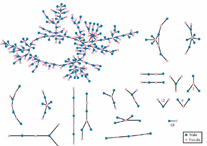
« PREVIOUS ENTRY
Fidget those pounds away
NEXT ENTRY »
TV torture: My column for New York magazine

This is really, really cool: James Moody, a sociologist at Ohio State University, mapped all the romantic and sexual connections that had taken place an 18-month period at a 1,000-person high school, in a rural mostly-white area. Remarkably, he got 832 of the students to talk to him. He mapped out the connections, in that graph above. See that one huge clump? That’s the most interesting part, as a university press release notes:
The most striking feature of the network was a single component that connected 52 percent (288) of the romantically involved students at Jefferson. This means student A had relations with student B, who had relations with student C and so on, connecting all 288 of these students.
While this component is large, it has numerous short branches and is very broad – the two most distant individuals are 37 steps apart. (Or to use a currently popular term, there were 37 degrees of separation between the two most-distant students.)
“From a student’s perspective, a large chain like this would boggle the mind,” Moody said. “They might know that their partner had a previous partner. But they don’t think about the fact that this partner had a previous partner, who had a partner, and so on.
“What this shows, for the first time, is that there are many of these links in a chain, going far beyond what anyone could see and hold in their head.”
There seems to be a quantum leap in the size of one’s zooming network. Either you belonged to that enormous, borg-like structure — about half the students — or you belonged to a very small, sealed-off network of three or fewer students. There was almost no-one in the middle: Almost no-one in a network of 4 to 15 students. In a way, it freakily reinforces the age-old virgin-whore typology of teen sexuality. Kids who wanted to be exclusive and monogamous dated likeminded kids, producing the sealed-off small networks; kids who dated more freely would hook up with those who also dated that way, producing the massive, interlocking chain.
This might be useful data in understanding how sexually-transmitted diseases spread in high schools. I’d be even more fascinated to see what the patterns would look like in one of those schools where students take the “chastity pledge” not to have sex before marriage. A while ago, I read the study that two professors did of the pledge’s effect (a PDF of it is here) and it was quite interesting: Taking the pledge greatly delayed whether a teenager actually had sex, to the extent that a non-pledging teenager was as likely to have sex with his/her first dating partner as a pledge-taking teenager who was on his/her fourth dating partner. The problem, the scientists discovered, is that the pledge only worked if the pledge-takers comprised a minority of the highschool population. That’s because the pledge was regarded as a badge of nonconformist pride. Ironically, if too many people in the school actually take the pledge, it doesn’t work any more. Worse, when pledge-takers eventually did have sex, they were far less likely than non-pledge-takers to use birth control and to guard against STDs. (Notably, when the government officials released these results and proudly announced that pledges were an “effective tool”, they downplayed this latter finding and completely failed to report the fact that the pledge works less the more people take it.) Anyway, I’d love to see what one of Moody’s charts looks like for a “pledging” school!
The other question, of course, is whether the kids were actually telling Moody the truth. There would be all sorts of reasons for teens to lie — either overreporting (to seem sexually adventurous), or underreporting (to keep from looking like they were too loose).
(Thanks to Boing Boing for this one!)
I'm Clive Thompson, the author of Smarter Than You Think: How Technology is Changing Our Minds for the Better (Penguin Press). You can order the book now at Amazon, Barnes and Noble, Powells, Indiebound, or through your local bookstore! I'm also a contributing writer for the New York Times Magazine and a columnist for Wired magazine. Email is here or ping me via the antiquated form of AOL IM (pomeranian99).

ECHO
Erik Weissengruber
Vespaboy
Terri Senft
Tom Igoe
El Rey Del Art
Morgan Noel
Maura Johnston
Cori Eckert
Heather Gold
Andrew Hearst
Chris Allbritton
Bret Dawson
Michele Tepper
Sharyn November
Gail Jaitin
Barnaby Marshall
Frankly, I'd Rather Not
The Shifted Librarian
Ryan Bigge
Nick Denton
Howard Sherman's Nuggets
Serial Deviant
Ellen McDermott
Jeff Liu
Marc Kelsey
Chris Shieh
Iron Monkey
Diversions
Rob Toole
Donut Rock City
Ross Judson
Idle Words
J-Walk Blog
The Antic Muse
Tribblescape
Little Things
Jeff Heer
Abstract Dynamics
Snark Market
Plastic Bag
Sensory Impact
Incoming Signals
MemeFirst
MemoryCard
Majikthise
Ludonauts
Boing Boing
Slashdot
Atrios
Smart Mobs
Plastic
Ludology.org
The Feature
Gizmodo
game girl
Mindjack
Techdirt Wireless News
Corante Gaming blog
Corante Social Software blog
ECHO
SciTech Daily
Arts and Letters Daily
Textually.org
BlogPulse
Robots.net
Alan Reiter's Wireless Data Weblog
Brad DeLong
Viral Marketing Blog
Gameblogs
Slashdot Games